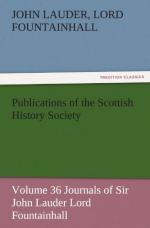[38] With regard to the etymology
of ‘leg,’ Mr. Hallen in his
introduction
to the Account Book of Sir John Foulis of Ravelston
(S.H.S.),
p. xxxiii, gives some strong and perhaps convincing
reasons
in favour of Liege. But the descriptions in the
Proclamation
above quoted, and the fact that Lauder sometimes
calls
them ‘legged,’ seem to show that the popular
etymology in
Scotland
was the man’s leg on the coin.
Charles II. struck four merk-pieces at the issue value of 53s. 4d. Scots in two issues, the first in 1664, the second in 1675-1682. The second, and only the second issue, came at some later but unknown period to be known to numismatists as dollars. But I do not think there is any reason to suppose that Lauder called those pieces dollars. The accounts are in the period of the first issue, and Lander’s dollar was of higher value. Probably his dollars were all foreign coins, generally rex dollars, as he often calls them. When they are leg dollars, he appears always so to distinguish them.
(4) The Merk, 13s. 4d. Scots, was raised in value by James VI. to 13- 1/2d. sterling, to make it interchangeable with English money. He coined none after his accession to the throne of England, and probably intended that no more should be coined. But the merk had too strong a hold in Scotland, and half merks were struck by Charles I., and various multiples and parts of merks by Charles II. at the old issue value of 13s. 4d. the merk. On the other hand, in 1651 Parliament ‘cryed up’ the 12s. Scots piece—equal to the English shilling—to one merk; and in 1625 the Britain crown or 31. Scots piece is officially described as ’known as the five merk piece,’ though its issue value was only five shillings. This illustrates the confusion and uncertainty of the relative value of coins, of which parenthetically two other examples may be given. On 20th June 1673 Lauder notes the receipt of his year’s salary as one of the assessors for the burgh, ‘being 150 lb. Scots, which is about 229 merks,’ whereas with the merk at 13s. 4d. (the standard value), 150 lb. is exactly 225 merks. In the same way he constantly states the same salary indifferently at 1501. Scots or L12 sterling, whereas 1501. Scots ought to have been equal to L12, 10s. sterling.
(5) Shilling. Lauder applies the name without distinction to the English shilling, 12s. Scots piece, which at page 80 he calls our shilling, and to the shilling Scots. The context generally shows which he means.
(6) Groat. Lauder’s groat is the English groat of four pence, sterling. The groat Scots of less value had not been coined for a century.
(7) Penny. As in the case of the shilling, Lauder uses the name indifferently for English pence and pennies Scots, but more often English.
Such coins as testoons, placks, bodles, bawbees and turners, do not appear in his accounts, but some of them are casually mentioned in the text of the MSS., and are explained in footnotes.




